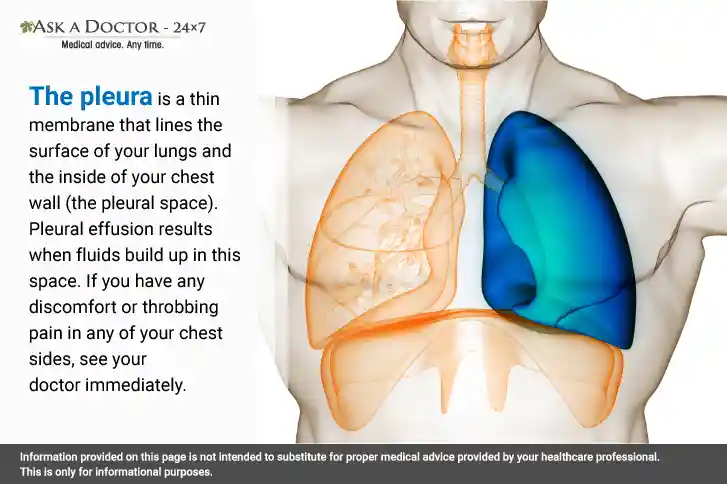Know All About Pleural Effusion
Everyone has a small amount of fluid between the lung and the chest wall (the pleural space). However, this fluid's normal balance can occasionally be upset. When your lungs are secreting too much liquid and not reabsorbing it enough, it's called a pleural effusion (water on the lungs). The excess fluid in the pleural space can compress the lungs, causing shortness of breath and chest pain. It can happen for various reasons, ranging from an infection to cancer.
In this blog, we will learn about the causes, symptoms, and available treatment for effectively addressing and managing pleural effusion.
Causes of Pleural Effusion

There are many causes of a pleural effusion. Depending on the cause, your doctor will determine the treatment option. Common causes include:
- Infections caused by bacteria or virus such as pneumonia, tuberculosis, or COVID-19
- Pulmonary embolism (blood clot in the lung vessel): One of the most common causes of unexplained pleural effusion
- Cirrhosis, specifically hepatic hydrothorax, occurs when fluid from ascites (fluid buildup in the abdomen) passes through diaphragmatic defects into the pleural space, the area around the lungs, leading to the extra fluid accumulation.
- Kidney disorders like nephrotic syndrome
- Lung cancer or other cancer that spreads to the lungs
- Autoimmune diseases (like rheumatoid arthritis or lupus)
- Exposure to asbestos
- Certain medications, such as methotrexate, phenytoin, or amiodarone
- Radiation therapy
- Ruptured esophagus
- Complications from open-heart surgery
- Congestive heart failure (CHF): Most common cause of pleural effusion, brought on by inadequate cardiac function and a diminished capacity of the heart to pump blood efficiently
Signs and Symptoms of Pleural Effusion?
Pleural effusion symptoms and indicators include:
- Dry cough
- Chest pain (sharp), particularly when taking a deep breath (also known as pleuritic pain or pleurisy)
- Inability to catch your breath (shortness of breath)
- Fever and chills
- Trouble breathing when lying down.
Diagnosis of Pleural Effusion
The doctor initially conducts a complete physical exam of the patient to examine if any external signs indicate problems with the lungs and breathing.
Additionally, your healthcare professional would suggest imaging tests, such as a chest x-ray or advanced scans like computed tomography (CT) of the chest and lungs, magnetic resonance imaging (MRI), and ultrasounds to observe the precise location of the fluid leak.
Treatment for Pleural Effusion
The pleural effusion treatment focuses on flushing out the excess fluid and keeping it from collecting again. The doctor starts the appropriate treatment procedures as soon as the patient's pleural effusions' exact cause and location are determined.
The cause of the fluid buildup needs to be determined, and medicine may be prescribed accordingly. For instance:
- For heart failure, you may receive diuretics or other heart failure medications to treat water accumulation in the pleural cavity.
- For infection, antibiotics will be given. Sometimes, additional treatment is needed.
- For water buildup due to cancer, liver disease, or kidney disease, treatment is directed at managing these conditions. Example: For a malignant effusion, you may require chemotherapy, radiation therapy, or a medication infusion within your chest.
Apart from the above medicinal intervention, certain advanced protocols are also required to drain extra accumulated fluid in the area surrounding the lungs when the pleural effusion is substantial and there is a severe infection or inflammation. Your healthcare professional can use therapeutic thoracentesis or a chest tube to drain a pleural effusion to control respiratory symptoms. Before the procedure, you’ll be given a local anesthetic to reduce any discomfort. Some pain or discomfort may occur at the incision site after the anesthetic wears off, which can be managed with the use of painkillers. However, if the fluid buildup recurs, the procedure may need to be repeated.
Besides the ICD, two primary surgical procedures done to remove pleural are:
- Video-assisted thoracoscopic surgery (VATS): This minimally invasive method involves making one to three small incisions (mostly half-inch) in the chest.
- Thoracotomy (traditional, open thoracic surgery): It involves a larger incision, usually 6 to 8 inches, in the chest from the pleural space to remove fibrous tissue and clear out infections. Clear tubes are left for drainage, ranging from two days to two weeks.
Conclusion
Hence, pleural effusion occurs when extra fluid collects in the pleural cavity, making breathing difficult. Common symptoms include shortness of breath, chest pain, cough, and fatigue. Pleural effusion can affect the respiratory system badly, but if diagnosed and taken care of promptly, it is possible to keep it controlled. A pleural effusion that’s causing significant respiratory distress can typically benefit from an immediate fluid-draining procedure called a therapeutic thoracentesis. Consult your healthcare provider for effective management of possible pleural effusion to clear up the liquid build-up in your lungs. Also, pleural effusion can indicate a serious underlying condition (like heart failure) that your doctor can take care of.
If you have any questions related to pleural effusion, you can Ask a Pulmonologist at Ask a Doctor - 24x7.
Recently Answered Queries Related to Pleural Effusion
- Help Me Understand Pneumonia, Breathing Trouble, Mild Pleural Effusion
- Could Breathing Difficulty Be Due To Pleural Effusion And Increased SGPT And SGOT?
- Can Pleural Effusion Be Malignant?
- Suggest Treatment For Breathlessness And Chest Pain While Having Tuberculosis
- Can Pulmonary Hypertension Cause Pleural Effusion?
- Suggest A Suitable Sleeping Position For A Person With Pleural Effusion
- How Can A Chesty Cough With Acute Pain Be Treated?
- What Is The Treatment Suggested For Pleural Effusion Thickening?
- What Does This Ultrasound Report For Upper Quadrant Pain Indicate?
Disclaimer: Information provided on this page is not intended to substitute for proper medical advice provided by your healthcare professional. This is only for informational purposes.
Ask a Specialist
Recent Questions


